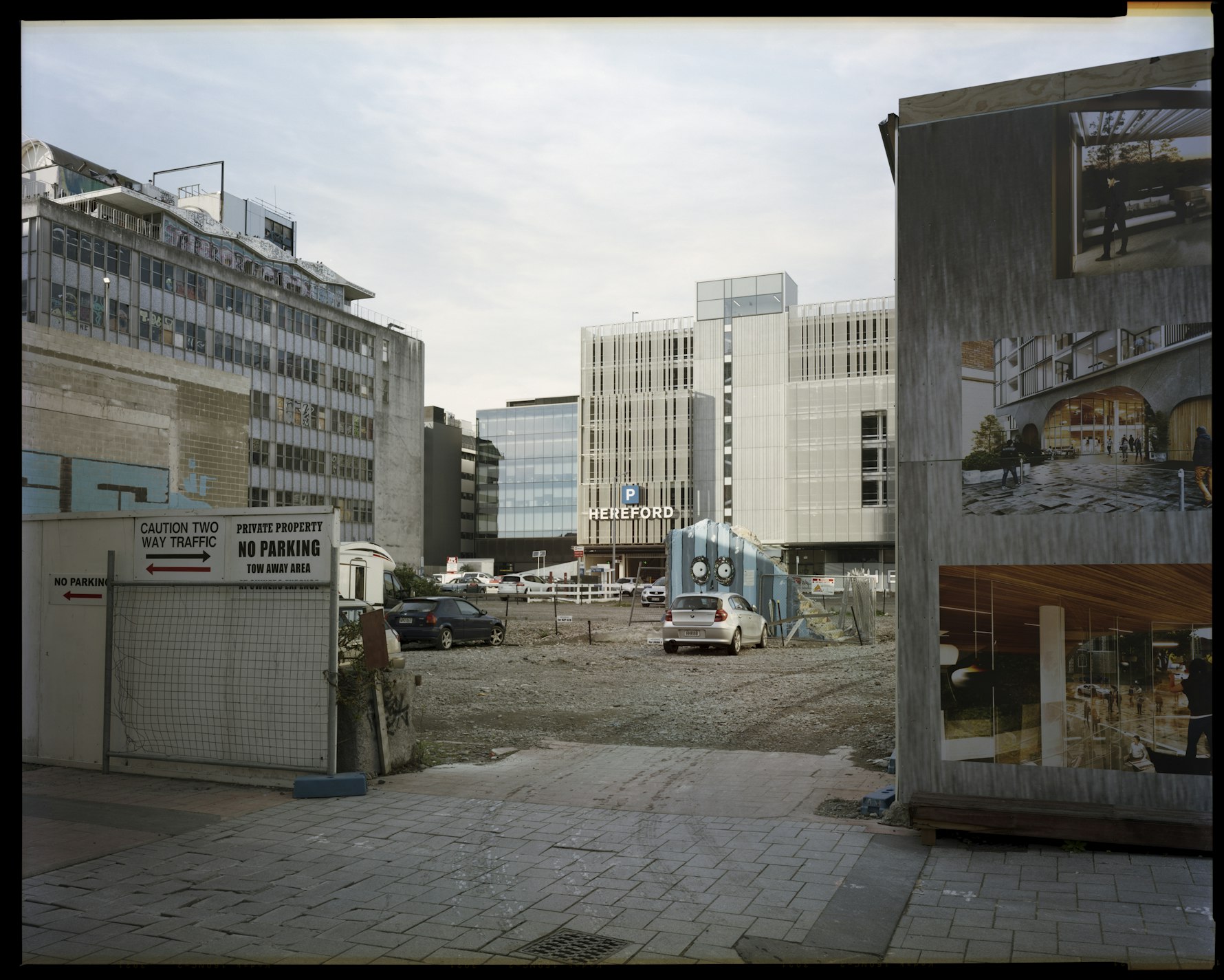In September of 2017 Auckland based photographer and publisher, Haruhiko Sameshima was invited to undertake a short, 3 week teaching and artist residency within the photography studio at the School of Fine Arts, University of Canterbury. With financial help from a U.C. Harkness Fund grant, Sameshima was asked to mentor and work alongside a group of second year students as they undertook a collaborative documentary project photographing Christchurch’s central city rebuild.
In order to try grasp what he was getting himself into, Sameshima visited Christchurch before starting his residency and spent the best part of a week exploring the central city streets; the first time he’d ever stayed more than a few hours within the four avenues. During this time, he tried to reconcile for himself what he’d read and seen on television about the scale of the disaster and recovery, with what he could see with his own eyes.
During the course of these initial explorations, Sameshima and I spoke at length about what he felt was a situation impossible for any outsider to comprehend, let alone depict in a way that communicated any great insight into the realities the city and its people faced in the wake of disaster. He asserted –with characteristic modesty – that while the best he could hope for would be to somehow make images that hinted at elements of history and / or proposed futures, someone in his position could really only ever address the here and now; reproduce views of a city seen through the eyes of someone unburdened by personal memories or politics associated with place, and unfamiliar with what has been or is in the process of being changed forever.
Alongside this kind of preparatory ‘field research’, Sameshima was also able to draw inspiration from his knowledge and appreciation of the work of 19thand early 20thCentury photography. He spent a lot of time looking at images contained within the Canterbury Museum and Alexander Turnbull Library collections, including work by Christchurch photographer, Dr. Alfred Barker, who travelled to Christchurch as a surgeon on the Charlotte Jane in the year 1850. Using wet plate photographic processes and documenting with great proficiency the early settlement and development of Christchurch, Dr. Barker’s photographs often depicted sightlines that until widescale post-earthquake demolition work had not been seen since the turn of the 19thCentury. Conscious of Dr. Barker’s images and significance to Christchurch – but never trying to replicate or parody his work – Sameshima chose to embark on his residency using a Deardorff 8x10” plate camera, a case of dusty, vintage lenses and several boxes of long-expired colour and black and white sheet film. As is typical with Sameshima’s diverse practice, the processes he chose to employ were of fundamental service to his thoughts and vision. Often standing for hours on end in one location, I’d fetch him cups of coffee – short black with a touch of extra hot water – while he pondered whatever it was his lens was pointing towards. “It’s like I’ve joined the priesthood,” he said one evening while waiting for the wind to drop and the clouds to part. “Every sheet of film is precious. Only one shot. It’s a real test of patience, discipline and commitment.”
At the end of each day, Sameshima would return to the School of Fine Arts to use the darkrooms and process his images. The expired film in conjunction with the changeable nature of the chemistry he used to develop it produced remarkable effects. Subtle and sometimes not-so-subtle colour shifts pushed things into unpredictable territory; mottling caused by oxidised Kodak D-76 developer resulted in an effect akin to the look of Dr. Barker’s iconic wet plate images. In a seemingly effortless way and in exceptionally short time, Sameshima produced what could be considered a supplementary chapter to his iconic book, Bold Centuries; a body of work that questions the language of photography and its history of use in New Zealand – perhaps more than how it is utilised as a means of representing the world through the presentation of a series of visual cues, facts and codes. The images that make up this concise portfolio certainly depict the here and now; the views that will surely disappear as new buildings are developed to obstruct sightlines and more “old dungers” go “under the hammer” (thanks, Gerry Brownlee), but they also serve as potent reminders of the extraordinary power of photography to not only memorialise and describe aspects of the world around us, but also hint at things felt and not necessarily seen.
To Haruhiko Sameshima, I say put modesty aside. You’ve easily exceeded your own expectations. More importantly however, you’ve produced a body of work that can teach us all a thing or two about the difference between seeing and looking.
– Tim J. Veling


















